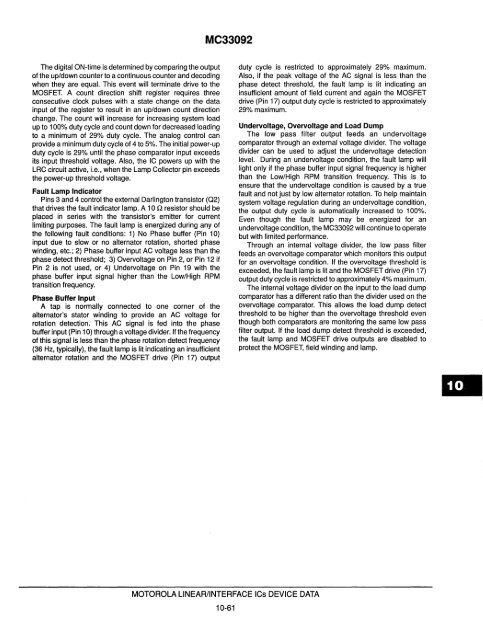Voltage References
Voltage References
Voltage References
You also want an ePaper? Increase the reach of your titles
YUMPU automatically turns print PDFs into web optimized ePapers that Google loves.
The digital ON-time is determined by comparing the output<br />
of the up/down counter to a continuous counter and decoding<br />
when they are equal. This event will terminate drive to the<br />
MOSFET. A count direction shift register requires three<br />
consecutive clock pulses with a state change on the data<br />
input of the register to result in an up/down count direction<br />
change. The count will increase for increasing system load<br />
up to 100% duty cycle and count down for decreased loading<br />
to a minimum of 29% duty cycle. The analog control can<br />
provide a minimum duty cycle of 4 to 5%. The initial power-up<br />
duty cycle is 29% until the phase comparator input exceeds<br />
its input threshold voltage. Also, the IC powers up with the<br />
LRC circuit active, i.e., when the Lamp Collector pin exceeds<br />
the power-up threshold voltage.<br />
Fault Lamp Indicator<br />
Pins 3 and 4 control the external Darlington transistor (Q2)<br />
that drives the fault indicator lamp. A Ion resistor should be<br />
placed in series with the transistor's emitter for current<br />
limiting purposes. The fault lamp is energized during any of<br />
the following fault conditions: 1) No Phase buffer (Pin 10)<br />
input due to slow or no alternator rotation, shorted phase<br />
winding, etc.; 2) Phase buffer input AC voltage less than the<br />
phase detect threshold; 3) Overvoltage on Pin 2, or Pin 12 if<br />
Pin 2 is not used, or 4) Undervoltage on Pin 19 with the<br />
phase buffer input signal higher than the Low/High RPM<br />
transition frequency.<br />
Phase Buffer Input<br />
A tap is normally connected to one corner of the<br />
alternator's stator winding to provide an AC voltage for<br />
rotation detection. This AC signal is fed into the phase<br />
buffer input (Pin 10) through a voltage divider. If the frequency<br />
of this signal is less than the phase rotation detect frequency<br />
(36 Hz, typically), the fault lamp is lit indicating an insufficient<br />
alternator rotation and the MOSFET drive (Pin 17) output<br />
MC33092<br />
MOTOROLA LINEAR/INTERFACE ICs DEVICE DATA<br />
10-61<br />
duty cycle is restricted to approximately 29% maximum.<br />
Also, if the peak voltage of the AC signal is less than the<br />
phase detect threshold, the fault lamp is lit indicating an<br />
insufficient amount of field current and again the MOSFET<br />
drive (Pin 17) output duty cycle is restricted to approximately<br />
29% maximum.<br />
Undervoltage, Overvoltage and Load Dump<br />
The low pass filter output feeds an undervoltage<br />
comparator through an external voltage divider. The voltage<br />
divider can be used to adjust the undervoltage detection<br />
level. During an undervoltage condition, the fault lamp will<br />
light only if the phase buffer input signal frequency is higher<br />
than the Low/High RPM transition frequency. This is to<br />
ensure that the undervoltage condition is caused by a true<br />
fault and not just by low alternator rotation. To help maintain<br />
system voltage regulation during an undervoltage condition,<br />
the output duty cycle is automatically increased to 100%.<br />
Even though the fault lamp may be energized for an<br />
undervoltage condition, the MC33092 will continue to operate<br />
but with limited performance.<br />
Through an internal voltage divider, the low pass filter<br />
feeds an overvoltage comparator which monitors this output<br />
for an overvoltage condition. If the overvoltage threshold is<br />
exceeded, the fault lamp is lit and the MOSFET drive (Pin 17)<br />
output duty cycle is restricted to approximately 4% maximum.<br />
The internal voltage divider on the input to the load dump<br />
comparator has a different ratio than the divider used on the<br />
overvoltage comparator. This allows the load dump detect<br />
threshold to be higher than the overvoltage threshold even<br />
though both comparators are monitoring the same low pass<br />
filter output. If the load dump detect threshold is exceeded,<br />
the fault lamp and MOSFET drive outputs are disabled to<br />
protect the MOSFET, field winding and lamp.

















